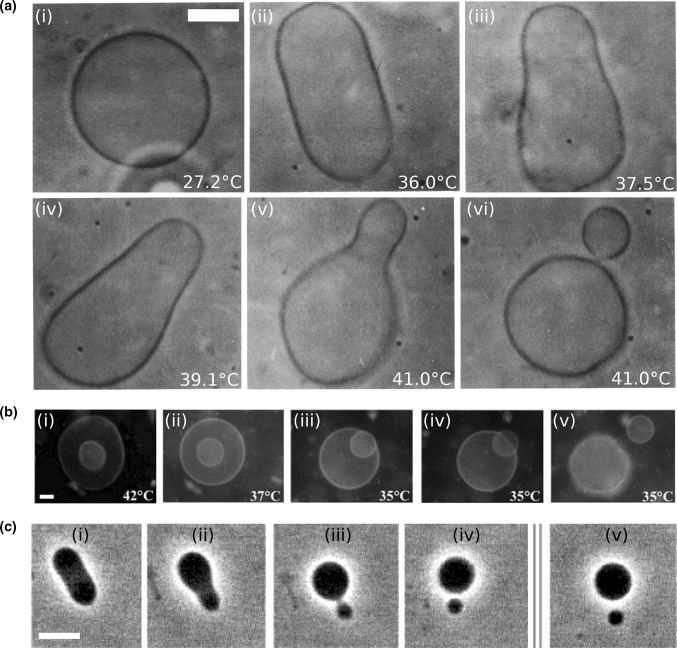Fig. 1.
Shape trajectories for vesicles that are physically manipulated. a A DPMC vesicle is heated from  (i) to
(i) to  (v). A further increase of the temperature by
(v). A further increase of the temperature by  transferred the shape of the vesicle from a pear to the limiting shape of two spheres that stay connected by a narrow neck (without abscission of the neck). Area increased from 2,570 to 2,820
transferred the shape of the vesicle from a pear to the limiting shape of two spheres that stay connected by a narrow neck (without abscission of the neck). Area increased from 2,570 to 2,820  , while volume changed only slightly from 12,200 to 12,000
, while volume changed only slightly from 12,200 to 12,000  . Note that before the heating cycle the vesicle was stiff and did not have any excess surface area. Scale bar 10
. Note that before the heating cycle the vesicle was stiff and did not have any excess surface area. Scale bar 10  . b Time series of the birthing of an inner vesicle through the membrane of a mother vesicle. A DLPE:DPPC 3:7 vesicle was cooled down from
. b Time series of the birthing of an inner vesicle through the membrane of a mother vesicle. A DLPE:DPPC 3:7 vesicle was cooled down from  (i) to
(i) to  (iii–v). The cooling process created an inner pressure that caused an inner bud (that had formed previously due to a heating process) to be ejaculated from the lumen of the mother vesicle. Scale bar 5
(iii–v). The cooling process created an inner pressure that caused an inner bud (that had formed previously due to a heating process) to be ejaculated from the lumen of the mother vesicle. Scale bar 5  . c Fission of a DPPC:cholesterol vesicle due to the incorporation of lyso-PC. Budding and fission were induced by the local injection of a solution of 1
. c Fission of a DPPC:cholesterol vesicle due to the incorporation of lyso-PC. Budding and fission were induced by the local injection of a solution of 1  palmitoyl-lyso-PC. Time after injection are 0, 17, 18, 40, and 240 s for (i)–(v), respectively. Scale bar 10
palmitoyl-lyso-PC. Time after injection are 0, 17, 18, 40, and 240 s for (i)–(v), respectively. Scale bar 10  . a Modified with permissions from reference Käs and Sackmann (1991)
. a Modified with permissions from reference Käs and Sackmann (1991)  (1991) Elsevier Limited. b Modified with permissions from reference Sakuma and Imai (2011)
(1991) Elsevier Limited. b Modified with permissions from reference Sakuma and Imai (2011)  (2011) American Physical Society. c Modified with permission from reference Tanaka et al. (2004)
(2011) American Physical Society. c Modified with permission from reference Tanaka et al. (2004)  (2004) American Chemical Society
(2004) American Chemical Society

